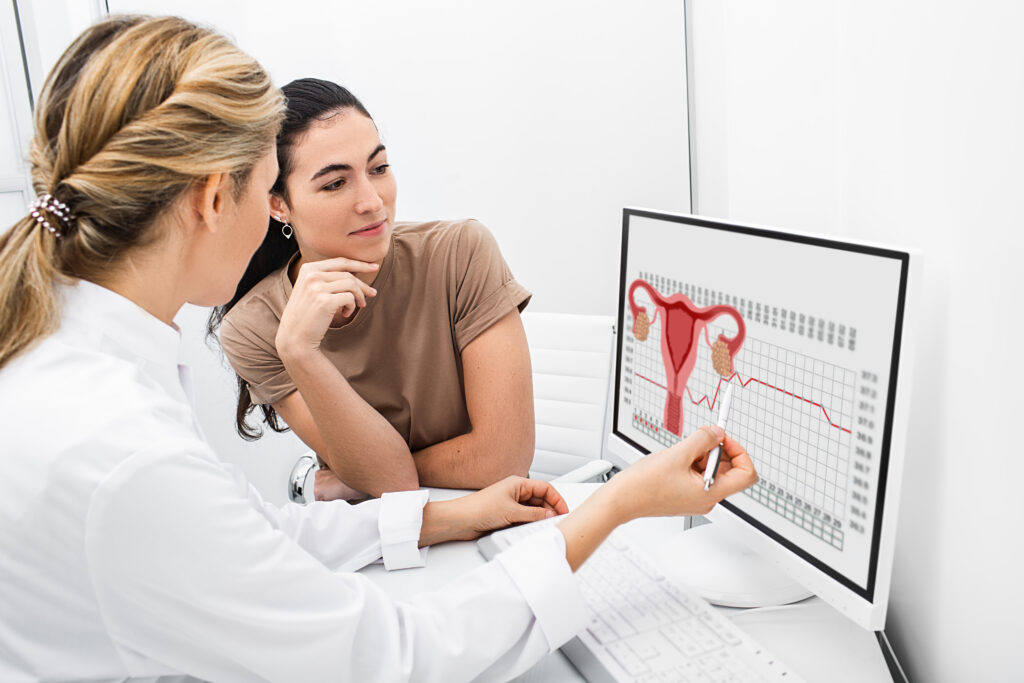Your doctor has prescribed Cyclogest® (Micronised Progesterone) as part of your fertility treatment
This section is designed to help explain why you have been prescribed Cyclogest®, how it can help on your fertility journey and how to use it.
We are aware that it is of utmost importance for you to understand why you have been prescribed Cyclogest® pessaries and how they work.
This section is not a replacement for the Patient Information Leaflet provided in the Cyclogest® pack, which you should read before using Cyclogest®.
Discover more about Cyclogest® below, including its therapeutic indications, the evidence supporting its use in luteal phase support (LPS) in assisted reproductive technology (ART) treatments, and why a Cyclogest® regime is demonstrated to be the preferred choice for clinicians surveyed in the UK1.


What is Cyclogest®?
Cyclogest® contains progesterone, a natural female sex hormone produced by your body.
The pessary is made of an exclusive vegetable fat which contains the progesterone evenly mixed within it.
Cyclogest® is a small, discreet pessary that should be inserted into the vagina or rectum, as directed by your doctor. The pessaries are self-lubricating, and their unique shape allows easy insertion without the need for an applicator.
Pessaries are a common form of administering medication. Cyclogest® pessaries provide a consistent and localised release of progesterone into the lining of the womb. Do not swallow Cyclogest® as it is not intended for oral use.
Cyclogest® is a convinient twice-daily vagine progesterone for Luteal Phase Support in ART.2
The preferred choice for Luteal Phase Support in 85% of IVF clinics surveyed in the UK.3
Supported across clinical trials with over 850 patients to have a demonstrated efficacy and safety profile.4,5
The preferred choice for Luteal Phase Support in 85% of IVF clinics surveyed in the UK.3
Supported across clinical trials with over 850 patients to have a demonstrated efficacy and safety profile.4,5
Demonstrated to have similar efficacy via both rectal and vaginal routes.6,7
Bioidentical to the progesterone produced by the patient’s body2 and micronised for optimised absorption.8,9
Demonstrated to have similar efficacy via both rectal and vaginal routes.6,7
Bioidentical to the progesterone produced by the patient’s body2 and micronised for optimised absorption.8,9
Why Cyclogest®?
The body sometimes needs a helping hand, and your progesterone levels may be lower than required. This is where Cyclogest® comes in. A little boost to your hormones helps the lining of the womb prepare for receiving an embryo. Once the embryo is implanted via IVF, progesterone can help it grow and develop.
It is clinically proven that women receiving progesterone during the luteal phase, as part of their fertility treatment, can achieve better pregnancy outcomes in comparison with those not using it.
What is Cyclogest® used for?
Cyclogest® works by supporting the hormonal balance within the body for the treatment of:
Why your doctor prescribed you Cyclogest®?

As part of your assisted reproductive technology or fertility treatment, the medications that are used to increase egg production and ensure ovulation can alter your body’s natural progesterone production. These procedures and medications used, unfortunately can cause low / altered levels of progesterone.
In the second part of menstrual cycle (aka the luteal phase) just after ovulation, progesterone is needed to thicken the inner wall of the womb (endometrium), which will help the embryo to implant.
Cyclogest® pessaries contain natural progesterone in micronised form with very small particles to maximise absorption by the cells. They provide the essential ‘luteal phase support’ at this critical stage of implantation of the embryo. It is proven with studies that when administered into the vagina or rectum (back passage), progesterone increases the chances of a successful pregnancy.
Based on recent UK guidelines updated by the National Institute of Health and Care Excellence (NICE), micronised vaginal progesterone is recommended to supplement the extra progesterone needed for other conditions as well. Please check with you doctor regarding how to use Cyclogest® pessaries for certain conditions.
What are the benefits of Cyclogest®?
• Cyclogest® contains a natural progesterone;
Cyclogest® is bioidentical to the progesterone produced by the mother-to-be’s body9. Natural progesterone has demonstrated to be well tolerated by the patient with reassuring outcomes for the developing foetus within them, and is more effective than synthetic derivatives in inducing secretory changes at the endometrium.10,11,12,13
• Cyclogest® is demonstrated to be well-tolerated;
In two different high-quality clinical studies, it was demonstrated that Cyclogest® is well tolerated by the patients.5,10 Side effect rates were comparable among patients treated with Cyclogest® and the majority of the side effects were mild or moderate in intensity and explained by the hormonal action of the administered drugs.5,10
• Cyclogest®’s convenience profile;
There are a number of ways in which Cyclogest® is a more convenient treatment option than other progesterone formulations:
• Cyclogest® can be inserted easily by the patient without the need of an applicator.
• Cyclogest® can be inserted easily by the patient without the need of an applicator.
• Cyclogest® provides a higher dosage treatment option;
The option of a higher dose formulation with Cyclogest® 400 mg will improve ART success rates and decrease the need for adding progesterone injections to the IVF treatments. This is more convenient both for the clinicians and for the patients and will also reduce the total cost of the treatment.13,14,15
Cyclogest is suitable for vegan and vegetarians. This is certified with the Vegan Society.
What you need to know before you use Cyclogest®?
- Pains in the calves or chest, a sudden shortness of breath or coughing blood indicating possible clots in the legs, heart, or lungs.
- Severe heachache or vomiting, dizziness, faintness, or changes in vision or speech, weakness or numbness of an arm or leg indicating possible clots in the brain or eye
- Worsening of depression.
• Liver problems such as jaundice (yellowing of the skin and whites of the eyes).
• Epilepsy.
How is Cyclogest® used?
Always use Cyclogest® pessaries as recommended by your doctor, prescriber or pharmacist.
Scan the QR code to download the Cyclogest® Patient Brochure:

Route of Administration video:
Is it better to use Cyclogest® vaginally or rectally?
Cyclogest® pessaries may be inserted into either the vagina or rectum (back passage) depending upon certain other conditions. You should insert Cyclogest® into the:
• Colitis (inflammation of the colon causing frequent attacks of diarrhoea with mucus or blood)
• Problems controlling your bowel movements (faecal incontinence)
• A vaginal infection (discharge from your vagina)
• Regular cystitis (a burning pain on passing water)
• Recently given birth.
• To use a barrier method of birth control such as a diaphragm, cap or condom. Such devices may not work properly in the presence of the hard fat from the pessary.
Always consult with your doctor with regards on how to use Cyclogest®.
What happens if you forget to use Cyclogest®?
It is important to take Cyclogest® pessaries at the same time each day in order to have a stable dose and to achieve a successful treatment. If you forget to insert a pessary, you should use it as soon as you remember, unless it is nearly time for the next dose. It is not recommended to use two doses together. It is important to remember to use the remaining doses at the correct time.
When is it not recommended to use Cyclogest® pessaries?
- You should always use Cyclogest® exactly as your doctor has instructed you.
- Check with your nurse, doctor or pharmacist if you are not sure.
- Stop using Cyclogest® and contact your nurse or doctor at once if you have an allergic reaction – signs of an allergic reaction include but are not limited to, a skin rash that may be itchy, shortness of breath and tongue swelling.
• Are allergic to progesterone or any of the other ingredients of this medicine (listed in the Patient Information Leaflet section 6)
• Have unusual vaginal bleeding that has not been evaluated by the doctor.
• Have known or suspected tumour that is hormone sensitive.
• Have porphyria disorders (a group of inherited or acquired disorders of certain enzymes)
• Have or have had blood clots in the legs, lungs, eyes or elsewhere in the body.
• Currently have or have had severe liver problems.
• Have a miscarriage and your physician suspects some tissue is still in the uterus or pregnancy outside of the womb.
• Are allergic to progesterone or any of the other ingredients of this medicine (listed in the Patient Information Leaflet section 6)
• Have unusual vaginal bleeding that has not been evaluated by the doctor.
• Have known or suspected tumour that is hormone sensitive.
• Have porphyria disorders (a group of inherited or acquired disorders of certain enzymes)
• Have or have had blood clots in the legs, lungs, eyes or elsewhere in the body.
• Currently have or have had severe liver problems.
• Have a miscarriage and your physician suspects some tissue is still in the uterus or pregnancy outside of the womb.
What are the possible side effects of Cyclogest® pessaries?
Cyclogest® is proven to be well tolerated, but like all medicines, there is a chance you may experience some side effects; such as drowsiness, stomach discomfort or hot flushes, although not everybody gets them. If you are concerned, speak to your healthcare professional.
Stop using Cyclogest® and contact your doctor at once if you have an allergic reaction. Signs of an allergic reaction include but are not limited to, a skin rash that may be itchy, shortness of breath and tongue swelling.
Common side effects (may affect up to 1 in 10 people):
- Abdominal Distension (swelling in the abdomen), Abdominal Pain, Constipation.
- Sleepiness, Tiredness.
- Hot Flush.
- Breast Pain.
• Headache, dizziness, mood changes.
• Change in taste, vomiting, flatulence (wind), diarrhoea, bloat (gastric dilatation).
• Night sweats, skin rash or itching.
• Joint pain, pelvic pain, ovarian enlargement, vaginal bleeding.
• Frequent urination, involuntary excretion of urine.
• Weight increase.
• Itching at the application site, feeling cold or body temperature change.
If you get any side effects, talk to your doctor, pharmacist or nurse. This includes any possible side effects not listed here or in the patient information leaflet. You can also report side effects directly via the Yellow Card Scheme at: www.mhra.gov.uk/yellowcard or via the Yellow Card app, which can be downloaded from the Apple App Store, or Google Play Store. By reporting side effects, you can help provide more information on the safety of Cyclogest®.
How to store Cyclogest® pessaries?
Like all medicines, please keep Cyclogest® pessaries out of the sight and reach of children.
Please store Cyclogest® pessaries in a cool and dry place below 30°C and do not use them after the expiry date which is stated on the pack. The expiry date refers to the last day of that month.
Do not throw away any medicines via wastewater or household waste and ask your pharmacist how to throw away medicines you no longer use. These measures will help protect the environment.
1. Russell R. et al. Duration of luteal support after IVF is important, so why is there no consistency in practice? The results of a dynamic survey of practice in the United Kingdom. Human Fertility, 2014; Early Online: 1–5 DOI: 10.3109/14647273.2014.921337
2. Cyclogest 400mg Summary of Product Characteristics. EMC. 2021. Available at: https://www.medicines.org.uk/emc/product/5569/smpc [Last accessed: March 2022].
3. Russell R, Kingsland C, Alfirevic Z, Gazvani R. Duration of luteal support after IVF is important, so why is there no consistency in practice? The results of a dynamic survey of practice in the United Kingdom. Human Fertility 2015;18:43-47. Available at: https://www.tandfonline.com/doi/full/10.3109/14647273.2014.921337 [Last accessed: March 2022].
4. Urbancsek J, Stamenov G, Kurecova B, Ljubic G, Magnusdottir TB, Hrafnsdottir S, Wargenau M, Klingmann I, D’Hooghe T. Randomized clinical trial to compare the pregnancy rates of vaginally applied progesterone 400 mg pessary and progesterone 8% gel after in-vitro fertilization. Human Reproduction 2017;32(Suppl 1):i53-54. Available at: https://academic.oup.com/humrep/article/32/suppl_1/i1/3926642 [Last accessed: May 2022].
5. Duijkers IJM, Klingmann I, Prinz R, Hrafnsdottir S, Magnusdottir ThB, Klipping C. Effect on endometrial histology and pharmacokinetics of different dose regimens of progesterone vaginal pessaries, in comparison with progesterone vaginal gel and placebo. Human Reproduction 2018;33:2131-2140. Available at: https://academic.oup.com/humrep/article/33/11/2131/5108541 [Last accessed: April 2022].
6. Aghsa MM, Rahmanpour H, Bagheri M, Davari-Tanha F, Nasr R. A randomized comparison of the efficacy, side effects and patient convenience between vaginal and rectal administration of Cyclogest® when used for luteal phase support in ICSI treatment. Archives of Gynecology and Obstetrics 2012;286:1049–1054. Available at: https://link.springer.com/article/10.1007/s00404-012- 2410-7 [Last accessed: April 2022].
7. Khrouf M, Slimani S, Khrouf MR, Braham M, Bouyahia M, Berjeb KK, Chaabane HE, Merdassi G, Kaffel AZ, Zhioua A, Zhioua F. Progesterone for Luteal Phase Support in In Vitro Fertilization: Comparison of Vaginal and Rectal Pessaries to Vaginal Capsules: A Randomized Controlled Study. Clinical Medicine Insights: Women’s Health 2017;9:43-47. Available at: https://www.ncbi.nlm.nih.gov/pmc/articles/PMC5217976/ [Last accessed: April 2022].
8. McAuley JW, Kroboth FJ, Kroboth PD. Oral Administration of Micronized Progesterone: A Review and More Experience. Pharmacotherapy 1996;16:453-457. Available at: https://accpjournals.onlinelibrary.wiley.com/doi/abs/10.1002/j.1875- 9114.1996.tb02977.x?sid=nlm%3Apubmed [Last accessed: April 2022].
9. Cyclogest 400mg pessaries. Patient Information Leaflet. Available at: https://www.medicines.org.uk/emc/product/5569/pil [Last accessed: April 2022].
10. Saunders H et al. Efficacy, safety and tolerability of progesterone vaginal pessaries versus progesterone vaginal gel for luteal phase support after in vitro fertilisation: a randomised controlled trial Human Reproduction, Vol.35, No.2, pp. 355–363, 2020 doi:10.1093/humrep/dez261
11. NICE (2021). Ectopic pregnancy and miscarriage: diagnosis and initial management. National Institute for Health and Care Excellence www.nice.org.uk/guidance/cg62/resources/guidance-antenatal-care-pdf
12. Simons NE et al. The long-term effect of prenatal progesterone treatment on child development, behaviour and health: a systematic review. BJOG 2021; 128: 964-974
13. Coomarasamy A et al. A Randomized Trial of Progesterone in Women with Bleeding in Early Pregnancy. N Engl J Med 2019;380:1815-24. DOI: 10.1056/NEJMoa1813730
14. Baldini GM et al. Evaluation of the ideal vaginal Progesterone effectiveness doses for luteal support in embryo thawing cycles after endometrial preparation without using the GnRh analogue. European Review for Medical and Pharmacological Sciences 2023; 27: 2018-2026
15. Melo P et al. Serum luteal phase progesterone in women undergoing frozen embryo transfer in assisted conception: a systematic review and meta-analysis. Fertility and Sterility® Vol. 116, No. 6, December 2021 0015-0282 https://doi.org/10.1016/j.fertnstert.2021.07.002
16. Stavridis K et al. Effectiveness of progesterone rescue in women presenting low circulating progesterone levels around the day of embryo transfer: a systematic review and meta-analysis Fertility and Sterility® Vol. 119, No. 6, June 2023 0015- 0282 https://doi.org/10.1016/j.fertnstert.2023.02.007
